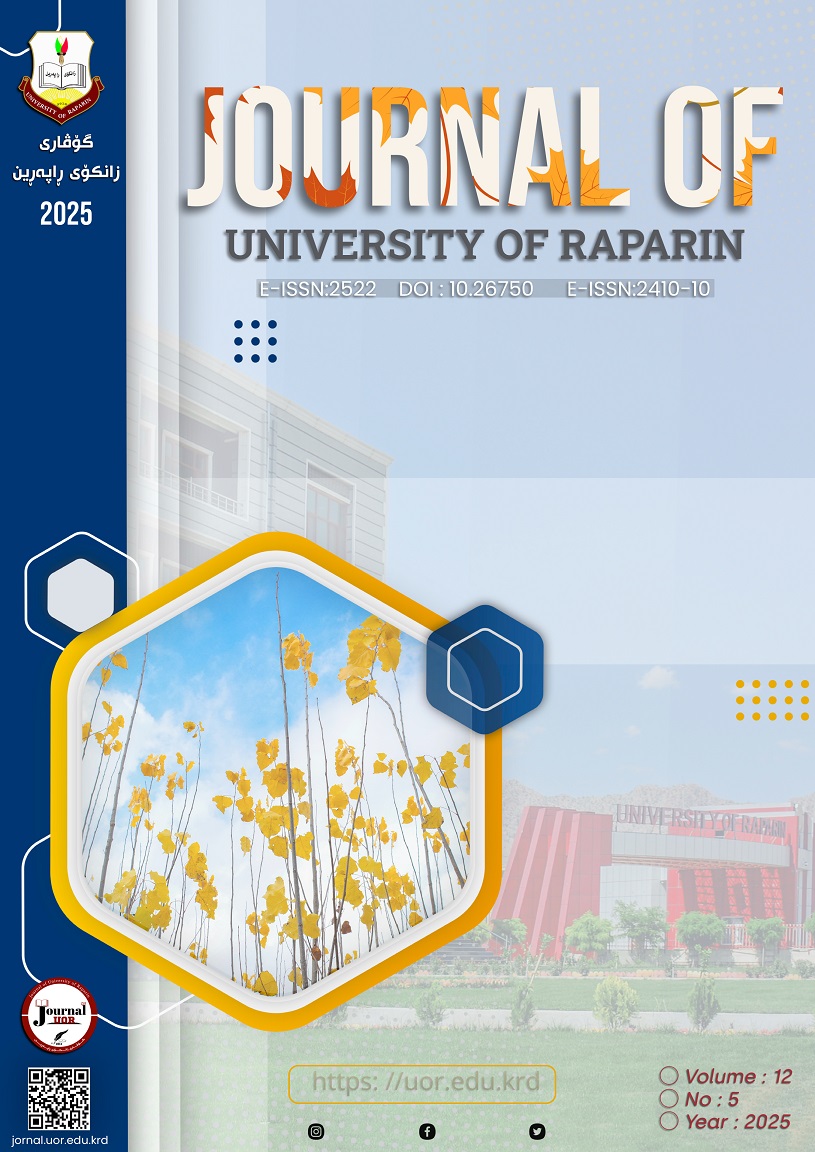Abstract
The purpose of this research is to examine the ambiguity with the level of usage of artificial intelligence and the degree of engagement by digital media channels in designing digital media content in the Kurdistan Region. Therefore, the research investigates the extent and manner of Artificial Intelligence (AI) usage and the benefits derived from it. It also explores the ambiguity with the application of artificial intelligence in Kurdish media communication, specifically for the purpose of utilizing AI in the work of graphic design for digital media in Kurdish media.
This issue has been identified as the core problem of the research. To reach accurate and scientifically valid results, the researcher used a questionnaire format along with in-depth interviews. The research is descriptive in nature and follows an analytical methodology. A purposive sample was selected, consisting of professional Kurdish digital media graphic designers who benefit from AI services. Also, the target population of this research includes Kurdish media professionals in the Kurdistan Region.
At the conclusion of the research, the researcher reached several findings, including:
Most designers working for official Kurdish digital media are from the younger generation, with the majority being around 25 years old. This is considered a positive point, as younger individuals are typically more technologically savvy and play an important role in using artificial intelligence for media production in digital platforms. However, the level of attention and engagement of Kurdish digital media channels with artificial intelligence remains quite low. This is viewed as a weakness of these institutions, as the channels have not taken serious steps to keep up with technological advancements. Additionally, in terms of educational qualifications, most of them hold diploma-level degrees. This indicates that they have a strong academic background in the field.
References
جوان اسعد احمد گەڵاڵی، ٢٠٢٣، ڕۆڵی ئنستاگرام لە ئاڕاستەکردنی پەیوەندییە کۆمەڵایەتییەکانی گەنجان لەهەرێمی کوردستاندا، نامەی ماستەر، پێشکەشی بەشی تەنیکی میدیا لە کۆلێژی تەکنیکی کارگێری زانکۆی پۆلیتەکنیکی سلێمانی کراوە.
دانا بەهادین مستەفا، ٢٠٢٣، ڕۆڵی ماڵپەری ئەلیکترۆنیی هەواڵیی کوردیی لە پێکهێنانی هۆشیاریی سیاسیی لای مامۆستایانی زانکۆی پۆلیتەکنیکی سلێمانی، نامەی ماستەر، پێشکەشی بەشی تەنیکی میدیا لە کۆلێژی تەکنیکی کارگێری زانکۆی پۆلیتەکنیکی سلێمانی کراوە.
سەرکەوت احمد محمد، ٢٠٢٣، كاریگەری نەخشەسازی لە گەیاندنی پەیامی میدیایی لە پێگە ئەلیكترۆنیيە كورديەكاندا، نامەی ماستەر پێشكەشی ئەنجومەنی كۆلێجی زانستە مرۆڤایەتیەكانی زانكۆی سلێمانی كراوە.
نەرمین مستەفا عوێز، ٢٠٢٤، ڕۆڵی گرافیک دیزاین وەک میدیای نوێ لە هونەری شێوەکاری هاوچەرخ لەهەرێمی کوردستانی عێراق، تێزی دکتۆرا، پێشکەشی ئەنجومەنی کۆلێژی هونەرە جوانەکان لە زانکۆی سلێمانی کراوە.
هێرش ڕەسول مراد، گۆران زیاد سمایل (٢٠٢٤) (ئاستی بەكارهێنانی زیرەکیی دەستكرد بۆ بەرهەمهێنانی ناوەرۆكی میدیایی لە دیجیتاڵ میدیا كوردییەكاندا) (دوەمین کۆنفرانسی نێودەوڵەتی زانستی میدیای دیجیتاڵی و کاریگەرییەکانی لەسەر ئاسایشی کۆمەڵگە لاسایەی یاسا نێوخۆیی و نێودەوڵەتییەکاندا).
هناء عبدالحميد شاور، (٢٠٢٣)، التصميم الجرافيكي وسيلة إتصال للتأثير على المجتمعات منذ القرن الثامن عشر وحتى القرن العشرين، بحوث في التربية الفنية والفنون، كلية التربية الفنية، جامعة حلوان.
نادر اسماعيل حمد، ٢٠١٧، أثير التصميم الجرافيكي على العالمة التجارية في الاردن من وجهة نظر طلبة السنة الرابعة في تخصص التصميم الجرافيكي بالجامعات، قدمت هذه الرسالة استكمال لمتطلبات الحصول على درجة الماجستير في التصميم الجرافيكي، قسم التصميم الجرافيكي، كلية العمارة والتصميم، جامعة الشرق الاوسط.
خزيمية، محمد منصور خليل، ٢٠٢٣، المسؤولية المدنية عن أضرار الذكاء الاصطناعي، رسالة الماجستير، الجامعة العربية الامريكية،جنين.
القاضي، رانية نادر غايب، ٢٠٢٣، المسؤولية المدنية عن أضرار الروبوتات ذات الذكاء الصطناعي، رسالة الماجستير، كلية الحقوق جامعة الشرق ألوسط.
دعاك، زهراء بنت ابراهيم بن يحي، ٢٠٢٣، قياس العوامل المؤثرة في استخدام تطبيقات الذكاء الاصطناعي لدى معلمي التعليم العام في ضوء النظرية الموحدة لقبول واستخدام التكنولوجيا، رسالة الماجستير، جامعة جازان كلية التربية قسم تقنيات التعليم.
حسین علی ابراهیم، ٢٠٢٣، انعكاسات تقنيات الذكاء الاصطناعي و أدواته على الممارسةالصحفية، مجلة دراسات و بحوث اعلامية، المجلد(٣)، ص (١-٢٦)، الجامعة العراقية.
مهند حميد عبيد، ٢٠٢٣، مستقبل العمل التلفزيونى فى ظل تحديات الذكاء الاصطناعي دراسة استشرافية، مجلة الباحث الآعلامي، المجلد(١٥)، العدد(٦٠)، الجامعة بغداد.
J-Abraham, 2020, Impact of Digital Media on Society, International Journal of Creative, Vol.8, Issue 5, Issn 2320-2882.
Gavin Ambrose, Paul Harris,2009, The Fundamentals of Graphic Design, first Published by AVA Publishing, United Kingdom, ISBN 2-940373-82-5.
Denizhan Arda, 2024, INVESTIGATION OF ARTIFICIAL INTELLIGENCE TOOLS IN DESIGN PROCESS AND CREATIVITY, IN PARTIAL FULFILLMENT OF THE REQUIREMENTS FOR THE DEGREE OF MASTER OF SCIENCE IN INDUSTRIAL DESIGN.
David Sinfield, 2013, Graphic Design in a Digital World, the International Journal of Design Education, VOLUME 7 ISSUE 1. First published in 2013 in Champaign, Illinois, USA.
Pu zhao, 2023, Artificial Intelligence-Based Digital Media Design Effect Enhancement Mechanism, Hindawi Advances in Multimedia Volume 2023, Article ID 8600543, 8 pages.
John Demuyakor, 2020, Opportunities and Challenges of Digital Media: A Comprehensive Literature Review of Ghana, Electronic Research Journal of Social Sciences and Humanities ISSN: 2706 – 8242, Vol 2: Issue II.
Chris, 2006, The History of Artificial Intelligence, Japan's Fifth Generation Computer System project.

This work is licensed under a Creative Commons Attribution-NonCommercial-NoDerivatives 4.0 International License.
Copyright (c) 2025 Journal of University of Raparin

